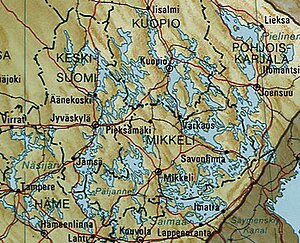
Back Finske søområde Danish Finnische Seenplatte German Finlandiako Aintziren Eskualdea Basque Järvi-Suomi Finnish Région des lacs de Finlande French Finn-tóvidék Hungarian Finlandia lacustre Italian フィンランド湖水地方 Japanese 호수수오미 Korean Finse Merenvlakte Dutch


Finnish Lakeland or Finnish lake district (Finnish: Järvi-Suomi, "Lake Finland", Swedish: Insjöfinland) is the largest of the four landscape regions into which the geography of Finland is divided.
The hilly, forest-covered landscape of the lake plateau is dominated by drumlins and by long sinuous eskers. Both are glacial remnants deposited after the continental glaciers that scoured and gouged the country's surface receded about 10,000 years ago.
The lake basins of the lakeland originate from the joint work of weathering and erosion of fractures in the bedrock. The erosion that made the depressions occurred before and during the Quaternary ice ages.[1] Erosion along fractures has produced linear inlets among the lakes.[2]
- ^ Behrens, Sven; Lundqvist, Thomas. "Finland: Terrängformer och berggrund". Nationalencyklopedin (in Swedish). Cydonia Development. Retrieved November 30, 2017.
- ^ Lindberg, Johan (April 4, 2016). "berggrund och ytformer". Uppslagsverket Finland (in Swedish). Retrieved November 30, 2017.
© MMXXIII Rich X Search. We shall prevail. All rights reserved. Rich X Search